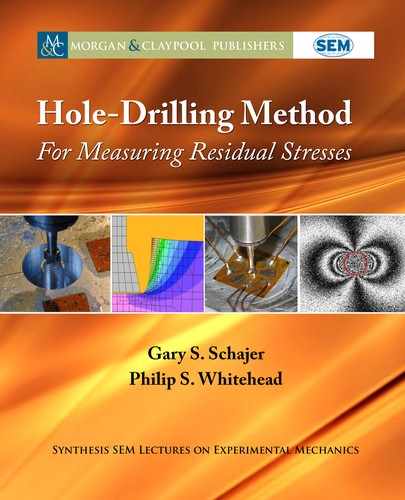
xiii
Preface
e Hole-Drilling Method is the most widely used relaxation type method for measuring resid-
ual stresses. Since its inception in the 1930s, the technique has dramatically grown and devel-
oped, with important new advances continually reported. e size and continued vitality of the
research literature on the subject testifies to the fertility and rich potential of the technique. Josef
Mathar, to whom this book is respectfully dedicated, would have had good reason to be proud
of the evolution of his elegant concept. It is very unfortunate that his life was cut short so that
he did not live to see the early flowerings of his foundational work.
While it may be said that the Hole-Drilling Method has one ancestor, it also has very
many family members, each of whom brings an important and diverse contribution to the tech-
nique. Josef Mathar certainly laid down the foundation of the method, in his published work he
also conceptually anticipated both the Ring-Core and Deep-Hole methods. However, the great
strength of the Hole-Drilling Method derives from the numerous subsequent workers who sub-
stantially and very skillfully expanded the concept. It was they who made it into the robust and
practical technique that it is today.
e authors are among the hole-drilling “family members,” each with experience of the
method extending over many years. It is our wish to share this experience with interested readers
and thereby contribute to the wider use of the Hole-Drilling Method and to its ongoing devel-
opment. is book is primarily intended as a practical handbook, although it is also hoped that
it will find good secondary use as a reference textbook. e target audience is measurement prac-
titioners, practicing engineers and students. In support of their needs we have endeavoured to
make the book contents as accessible as possible, while seeking to maintain a rigorous technical
standard. In this respect, our objectives parallel the idea indicated the title of a totally unrelated
work, e Prepared Table, a classical book of religious law written in the 16th century by Joseph
Karo. Neither of us have read the very specialized content, but the mental image conjured by
the inspired title vividly demonstrates the need to present a written work in a well-laid out and
accessible way analogous to how one would arrange the food on a dinner table for a welcome
guest. It is the task of the host to prepare the table so that the guest will find well-made and sat-
isfying things ready for them. We have endeavoured to achieve this objective within this book.
How well we may have succeeded will be up to the reader to judge. In places where we have
fallen short, it is hoped that a generous allowance may be granted.
e substantial size and variety of the hole-drilling literature has made it very challenging
for us to arrange our prepared table. ere are so many “foods” that we could serve, but excess
provision brings serious risk of indigestion. us, we have tried to follow a “keep it simple”
approach where we focus on the basic information. Each chapter also includes a thematic list
xiv PREFACE
of further readings so the reader can find further details on particular topics of interest. ese
readings are ones with which we happen to be familiar, but they certainly are not the only suitable
materials, possibly not even the best. Certainly, there is no adverse opinion implied by the non-
inclusion of other important work; for sure there is no monopoly of wisdom.
No enterprise can be undertaken without the substantial help of others. Our families,
friends and colleagues have generously helped and supported us in the preparation of this book.
Our parents have educated us and enabled us to reach our potential; this book is a flowering of
their efforts and is offered as a sign of our gratitude. Special thanks are also offered to the staff
members at Stresscraft Ltd., who all helped to prepare the strain gauge rosette installations and
drilled the holes for the examples included in this book; they are: Jeremy Lodge, Calum Pratt and
Patricia, Charlotte, Ian, Jamie and Matthew who are all members of the “Whitehead” family.
Also thanks to Prof. Philip Withers, Dr. Michael Prime, Prof. Drew Nelson, Prof. Armando
Albertazzi and Dr. Matias Viotti for their skillful reviews of the chapters. Prof. Lyndon Edwards
gave the idea of including quotes at the start of each chapter. Finally, Mr. Juuso Heikkinen
proof read the entire manuscript, suggested many clarifications, and rooted out numerous typos.
ank you all!
In keeping with the “pay forward” principle, all author royalties from the sale and distri-
bution of this book are contributed to the Leonard and Lilly Schajer Memorial Bursary Fund
at the University of British Columbia, Canada. Proceeds from the fund are used to support
Mechanical Engineering students in financial need. From among such students will come our
next generation of residual stress practitioners. We hope that we have prepared the table well for
them and we wish them every success.
Gary S. Schajer and Philip S. Whitehead
December 2017
..................Content has been hidden....................
You can't read the all page of ebook, please click here login for view all page.
